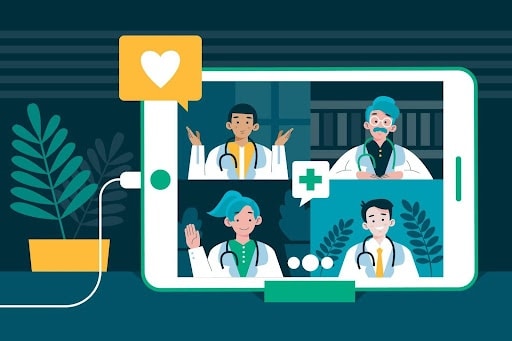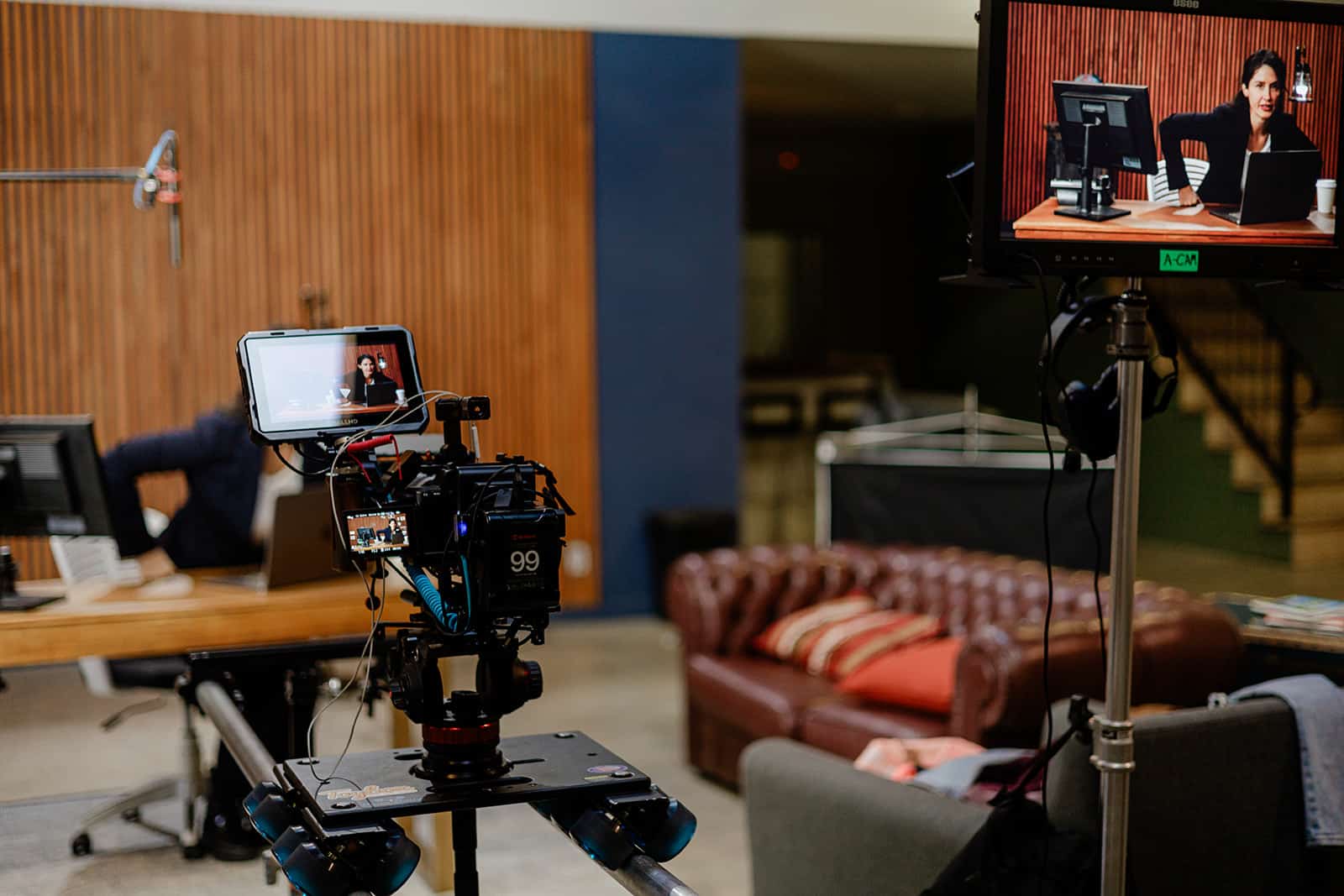We often search online for everything, from fever to skin rashes, almost by reflex, before considering seeing a doctor. Since everyone searches online, why not educate the public through videos?
This way, a patient will even understand complex medical information by sitting at home. This is how video production takes cues to incorporate healthcare into videos.
This blog post provides essential guidelines for healthcare video production trends to increase awareness. Healthcare providers and marketers can create videos to improve patient outcomes and strengthen their brand reputation by learning these.
| Take A Glance At The Healthcare Video Production Trends: → Healthcare videos have improved patients’ understanding of complex medical information. → Videos enhance doctor-patient communication and trust. → Increased accessibility to healthcare information for diverse populations. → Effective tool for patient education and behavior change. |
Current Trends in Healthcare Video Production
Patient Testimonial Video
When you see someone going through the same medical condition and recovering from it because of adequate healthcare, you feel assured and warm inside. That’s how a patient testimonial video works. These videos share the real-life experiences of patients, their struggles, and how they heal from them. It will significantly influence patient decisions and trust.
→ Authenticity and Trust Building
- Real stories: Videos showcase patients’ genuine experiences, challenges, and results without being too scripted portrayals.
- Raw Emotions: It allows patients to express their true emotions and talk openly about what they went through. This emotional connection builds empathy within viewers.
- Visual Storytelling: Using before-and-after images, visuals of medical equipment, and patients’ personal lives to relate to the patient’s story.
- Transparency: The main thing is keeping the video genuine. The video should focus on the patient’s story and the process without getting overly staged.
→ Best Practices for Creating Effective Testimonials
- Identify the Right Patients: Look for patients who are interested in telling their stories articulately.
- Set Clear Guidelines: Provide proper guidelines to help tell the story.
- Create a Comfortable Environment: To make patients feel at ease during the filming process, you can offer them gift cards or charitable donations.
- Professional Production: Try to incorporate a high-quality audio system to enhance the impact of the testimonial.
- Call to action: Give viewers a reason to take the next step, like scheduling an appointment or learning more about the services.
Educational and Informational Videos
You might watch medical documents by yourself and you can relate to the difficulty of sometimes understanding medical terms. But simple educational videos break down this complexity into digestible content.
→ Simplifying Complex Medical Information
- Use Plain Language: Try to use minimal medical jargon in the video; if needed, explain the term clearly and concisely.
- Break down Information: Divided complex topics into shorter portions in understandable segments.
- Use Analogies and Metaphors: Combine everyday life events into complex medical concepts to make them relatable.
- Visual Aids: Illustrating complex processes and structures using diagrams, graphics, and animation.
- Consider Your Audience: Tailor the complexity according to your audience. For example, in the same explainer video, one has to be in simpler language for the patient and the other with elaborate language to explain the medical professional.
→ Engaging Visuals and Animation
- Choose the Right Style: The animation style you choose should match the tone and target of your video. It can be 2D,3D, or motion.
- Tell a Story: Create an interesting narration to guide the viewers through the information.
- Use Color Effectively: A color palette brings emotion and helps differentiate information.
- Keep It Simple: Avoid overcrowding the screen with too many characters and information. Focus on clarity and readability.
Live Streaming and Webinars
Live streaming and webinars offer a unique way to connect with the audience in real time. This is an effective form of conducting medical events where professionals and patients can talk to each other.
→ Real-Time Interaction and Engagement
- Interactive Elements: Use polls, quizzes, and Q&A sessions to involve viewers.
- Real-time Chat: Encourage the audience to participate through live chat, asking questions and telling their problem.
- Guest Speaker: Invite expert medical professionals to join live or the event to engage in discussion.
- Pre-event engagement: Build anticipation by prompting the events and asking for questions beforehand.
→ Platforms and Tools for Live Streaming
- YouTube Live
- Facebook Live
- Instagram Live
- Zoom
- GoTo Webnier
Virtual Reality (VR) and Augmented Reality (AR)
VR and AR technologies are taking over the medical industry like a storm. This technology is one of the revolutionary moments in the healthcare sector, providing an immersive and interactive experience. It is creating major changes in patient care and satisfaction. You can use them to improve patient education, provide better facilities, and improve communication between patients and medical experts.
→ Use Cases and Examples
- Surgical Procedures: Patients can use VR to visualize the upcoming procedures to reduce anxiety and improve comprehension.
- Chronic Pain Management: VR-based therapies help soothe chronic pain through relaxation.
- PTSD Treatment: Immersive experience used to develop a coping mechanism for patients with traumatic events.
- Surgical simulation: VR-based training can enhance surgical skills and reduce errors.
→ Examples of Successful Implementation
| Stanford University: They develop a VR platform to help patients manage chronic pain through immersive experiences. Cleveland Clinic: Their surgical planning incorporates VR to improve patient outcomes. |
360-Degree Videos
Another great innovation helping the medical sector explore visions in all directions is 360-degree videos. These provide an immersive viewing experience for both patients and medical professionals. By building a sense of presence and control, you get more engagement for your healthcare services.
→ Immersive Experience for Viewers
- Exploration: Viewers feel excited and curious to discover hidden details and perspectives from the video.
- Sense of Presence: Users feel physically present in the video, which gives them a memorable experience.
- Emotional Connection: It creates stronger emotional responses by immersing viewers in a scene.
→ Applications in Healthcare Settings
- Virtual Hospital Tours: These tours familiarize patients with the environment and reduce their anxiety before procedures.
- Surgical Simulations: It creates real-life training sessions for surgeons and medical students.
- Physical Therapy: Provide interactive exercises and games to improve patient engagement and motivation.
- Patient Testimonials: Create immersive stories that build trust and credibility through view.
Social Media Videos
Social media covers half of the video content daily. Every day, 55% of individuals watch videos. So, to capture a mass audience, you will have to make short and engaging content.
→ Short, Engaging Content for Social Platforms
- Keep it clear and concise
- Hook the viewer immediately
- Narrate a story
- Use striking visual
- Optimize for sound-off viewing
- Incorporate captions
- Experiment with different formats
→ Tips for Maximizing Reach and Engagement
- Understand your audience
- Platform-specific optimization
- Use relevant hashtags
- Collaborate with a medical expert
- Analyze performance
- Regular posting
- Experiment and iterate
Essential Guidelines for Effective Healthcare Video Production

1. Understanding the Target Audience
The first step is to understand the target audience who will engage with healthcare videos. You will need to pinpoint the specific issues and needs before you tailor your content. This will ensure maximum impact.
→ Key Demographic Factors to Consider
- Age: Different age groups suffer from different health concerns.
- Gender: Making content that informs gender-specific health issues.
- Location: Geographical locations influence health disparities and cultural nuances.
- Education: Education level influences health literacy and preferred information formats.
- Health Status: Chronic condition, acute illness, or prevention care focus on guide content.
→ Tailoring Content to Audience Preferences
- Language and Tone: Use language that is clear and easy to understand.
- Content Format: Choose the format that the audience prefers the most.
- Visual Style: Select such visuals that resonate with the audience’s cultural background.
- Platform Selection: Post your content on platforms where your most of the audience gathers.
- Call to Action: Give clear and compelling calls to action that align with your audience’s goals.
2. Maintaining Compliance and Privacy
→ HIPAA Guidelines and Patient Confidentiality
While you are making a video with a patient, you will need to take great care of the information they provide you. Protecting a patient’s medical record comes under the Health Insurance Portability and Accountability Act (HIPAA) guidelines. So, when you are producing healthcare videos, keep these factors in mind:
- Patient Authorization: Take handwritten consent from patients before using their personal information and photos.
- Data Privacy: Ensure that sensitive information used during production is securely protected and has limited access control.
- Video Storage: Store the video file in a HIPAA-compliant environment. Take regular reviews and update security measures.
→ Legal Considerations in Video Production
Other than HIPAA, there are different legal requirements to consider when producing healthcare videos:
- Copyright: Avoid using copyrighted material without proper authorization.
- Defamation: Don’t add such content that can ruin any organization’s or individual’s reputation.
- Advertising Regulation: While creating the healthcare services video, emphasize the importance of following laws and regulations to increase awareness and authenticity.
- State-specific laws: Research state-specific laws and regulations before filming the video. This will prevent you from violating any pertinent laws in that area.
3. Ensuring High Production Quality
→ Investing in Good Equipment and Software
The quality of the video also determines whether your viewers will watch it or not. And that depends on the video production. High-quality video production requires the right tools to help with the video quality. Such as:
- Cameras with high resolution and low light performance give image stabilization.
- Audio quality is necessary, so invest in professional microphones and mixers for crisp sound.
- Lightning is important in creating a visual peeling video. Consider using both natural and artificial lights to enhance the visuals.
- Editing software polishes the final product with color correction, special effects, and audio mixings.
→ Professional Editing and Post-Production Tips
Your video truly starts to come to life after the post-production. Implementing editing and attention to detail transforms raw footage into a final product.
- Storyboarding: The editing process will flow the visual outline.
- Pacing: Maintain a consistent and engaging pace throughout the video.
- Color Correction: Make the visual attractive through color and contrast.
- Audio Editing: Add clean-up audio and background music to synchronize with the visuals.
- Visual Effects: Incorporate special effects to engage the audience with the video message.
- Proofreading: Review the video to fix any text, grammar, and spelling errors.
4. Crafting a Compelling Story
Storytelling is an effective tool in healthcare video production. You narrate a story about medical information that is both informative and emotionally engaging. Here are a few ways you can do it.
→ Storytelling Techniques for Healthcare Videos
- Character-driven Storytelling: Use the patient as the protagonist of the story and create the story around his journey.
- Conflict and Resolution: Introduce health challenges as conflict, then show how they were solved.
- Emotional Connections: Build empathy towards the story’s characters.
- Visual Storytelling: You can use images and various sound effects to increase impact on the audience.
- Call to Action: Encourage viewers to take action, such as sharing the video or seeking medical help.
→ Balancing Emotional Appeal with Informational Content
- Ensure all the medical data are accurate and up-to-date
- Present complex information in an understandable way
- Use graphics and animation to simplify hard concepts
- Incorporate expert testimonials to give the video credibility
- Blend emotional story and factual information
5. Optimizing Videos for SEO
Now, the time is to optimize the content so that users can find your health-related information on SERPs. Here’s how.
→ Keyword Research and Integration
- Identify relevant keywords
- Focus on long-tail keywords
- Incorporate keywords naturally
- Avoid keyword stuffing
→ Video Titles, Descriptions, and Tags
- Engaging titles that reflect the video content
- Detailed description that includes relevant keyword
- Relevant tags to discoverability
- Include a clear call to action
- Optimize for mobile
6. Measuring Success and ROI
To determine how your healthcare is doing, you will need to track the KPIs.
→ Key Metrics to Track
- Viewership Metrics: Total views, average watch time, play rate, audience demographics
- Engagement Metrics: Click-through rate, email subscriptions, website traffic, likes, comments, and shares
- Conversion Rates: Appointment bookings, lead generations, sales ROI
→ Analyzing Performance and Making Adjustments
- Identify top-performing videos that resonate most with your audience
- Understand how your audience intersects with your content
- Experiment with various video formats, lengths, and topics
- Make adjustments for better results
- Establish performance goals to measure
Case Studies and Examples

Studying successful healthcare video campaigns will give you insights into what works and what doesn’t. Here are a few stories of prosperous campaigns we have collected.
1. Apollo Hospitals: Patient Testimonial
- Campaign Focus: Apollo brings patients to tell their stories to build trust and credibility for their services.
- Success Factor: They showcase real people’s experiences in videos that create an emotional connection with potential patients. Apollo Hospital effectively highlights its achievements through its treatment. You will see how it humanized healthcare services for many.
2. NHS: Nursing Recurment Campaign
- Campaign Focus: Their motive is to recruit educated and skilled nurses to the profession
- Success Factors: The campaign focuses on showing how nurses deal with daily challenges and how the NHS rewards them for their work. Its main motive is to inspire new generations to become healthcare professionals. The campaign also shows the impact nurses have on patients’ lives.
3. Mayo Clinic: Medical Education Video
- Campaign Focus: Mayo Clinic provides clear and concise medical information through its educational video.
- Success Factors: They have become trusted sources of health information. Their simple yet informative content helps patients make informed decisions about their health.
Future Trends to Watch
It is necessary to note that the healthcare sector is no different from any sector—it is developing at a fast pace. Thus, it is possible to say that the methods of video production will change inevitably.
→ Emerging Trends and Technologies
- Artificial intelligence to automated video editing, personalized video content, and video analytics.
- VR/AR will used for immersive patient education, remote consultation, and surgical training.
- 5G technology for high-quality live streaming and real-time monitoring of patient vitals.
→ Predictions for the Future of Healthcare Video Production
- The hyper-personalization algorithm that uses AI will create video content exclusive to each individual.
- Videos will be optimized for people with disabilities.
- Video content will be integrated with wearable devices for personalized health monitoring.
- Such trends as TikTok and Instagram reels will shape healthcare video content.
Frequently Asked Questions
Video is important for healthcare awareness to enhance engagement, simplify complex information, and build trust.
Patient testimonials, educational videos, animation, and live stream are effective.
They adhere to HIPAA, take patients’ consent, secure data, and train staff on privacy regulations.
You will need high-resolution cameras, perfect lighting, audio mixers, video editing software, and a potential donor for VR gear.
Try using relevant keywords, engaging titles and descriptions, mobile optimization, and distributing in proper channels.
You should focus on tracking views, watch time, engagement, conversion, and ROI.
The predictions include AI-powered video editing, VR/AR integration, personalized video content, and increased use of short videos.
Ready To Make a Positive Difference in Healthcare with Video Production!
Videos have become a popular tool in the healthcare industry for everything from patient reviews to teaching tools. They use videos to connect with patients and reach out to prospective students and the public. If you are interested in utilizing these creative efforts for healthcare videos, then consider contacting LocalEyes. They have a great team to launch a great campaign and let the video tell everyone what you want them to know.

Founder at LocalEyes Video Production | Inc. 5000 CEO | Emmy Award Winning Producer








